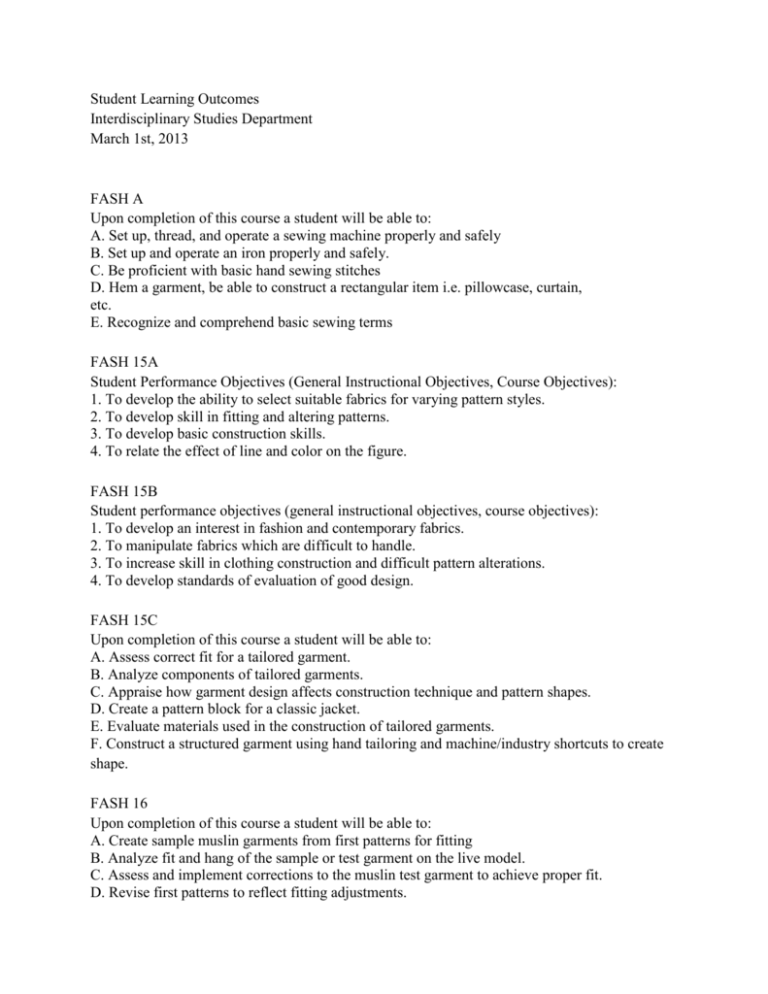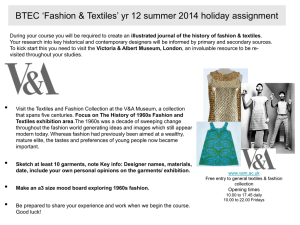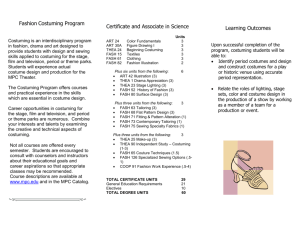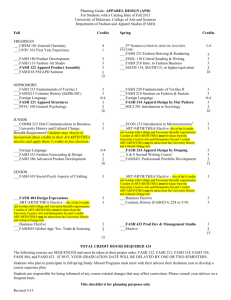Student Learning Outcomes Interdisciplinary Studies Department
advertisement

Student Learning Outcomes Interdisciplinary Studies Department March 1st, 2013 FASH A Upon completion of this course a student will be able to: A. Set up, thread, and operate a sewing machine properly and safely B. Set up and operate an iron properly and safely. C. Be proficient with basic hand sewing stitches D. Hem a garment, be able to construct a rectangular item i.e. pillowcase, curtain, etc. E. Recognize and comprehend basic sewing terms FASH 15A Student Performance Objectives (General Instructional Objectives, Course Objectives): 1. To develop the ability to select suitable fabrics for varying pattern styles. 2. To develop skill in fitting and altering patterns. 3. To develop basic construction skills. 4. To relate the effect of line and color on the figure. FASH 15B Student performance objectives (general instructional objectives, course objectives): 1. To develop an interest in fashion and contemporary fabrics. 2. To manipulate fabrics which are difficult to handle. 3. To increase skill in clothing construction and difficult pattern alterations. 4. To develop standards of evaluation of good design. FASH 15C Upon completion of this course a student will be able to: A. Assess correct fit for a tailored garment. B. Analyze components of tailored garments. C. Appraise how garment design affects construction technique and pattern shapes. D. Create a pattern block for a classic jacket. E. Evaluate materials used in the construction of tailored garments. F. Construct a structured garment using hand tailoring and machine/industry shortcuts to create shape. FASH 16 Upon completion of this course a student will be able to: A. Create sample muslin garments from first patterns for fitting B. Analyze fit and hang of the sample or test garment on the live model. C. Assess and implement corrections to the muslin test garment to achieve proper fit. D. Revise first patterns to reflect fitting adjustments. E. Construct final test garment to determine if further fitting adjustments are required. F. Translate all adjustments to create final production pattern. FASH 21 Upon completion of this course a student will be able to: A. Identify the specific technical skills, training and experience necessary for entry into a variety of fashion industry jobs. B. Demonstrate a solid command of industry-specific terminology, concepts and skills. C. Discuss the different careers available in the auxiliary fashion services. FASH 22 Upon completion of this course, students will be able to: 1. Identify the performance properties and physical characteristics of natural and man-made fibers. 2. Discuss materials and processes used in making man-made fibers. 3. Identify natural and some man-made fibers by means of simple physical, microscopic and chemical tests. 4. Identify the components of yarn construction 5. Analyze fabric construction to determine suitability for a particular use based on performance characteristics. 6. Interpret terms and information found on informative tags and labels which are required by law. 7. Discuss proper care and selection of textile products. 8. Understand new developments in the field of textiles, including new fibers, international trade and environmental issues. FASH 23 Upon completion of this course, students will be able to: 1. Recognize the historical changes in cultures and societies in Western Civilization as evidenced in fashion and other forms of material culture. 2. Distinguish these changes through details in the cut and design of clothing, fabric, and accessories. 3. Interpret the sociological value systems for each era as evidenced by trends in appearance. 4. Recognize historic influences in contemporary culture and fashion. FASH 25A Student Performance Objectives (General Instructional Objectives, Course Objectives): 1. To gain understanding of how textiles are constructed and what methods of construction are compatible with desired textile results. 2. To develop skill in: a. The selection, use, and care of the hand loom for constructing textiles. b. Selecting weaving materials suitable for desired finished textile effect. c. Planning proper textile construction techniques for textile design ideas. d. Analyzing characteristics and construction of manufactured textiles. 3. To increase awareness of the variety of textile resources available to the textile designer and textile consumer. 4. To develop an original textile design based on techniques and skills learned through practice on the handloom. FASH 25B Upon completion of this course, students should be able to: A. Interpret designs and instructions for advanced weave structures. B. Calculate amounts of warp and weft required and plan and construct original woven projects based on techniques and skills learned through sampling on the hand loom. e. Assess how textiles are constructed and what methods of construction are compatible with desired textiles results. D. Analyze the characteristics and construction of manufactured textiles. E. Present woven samples in a professional format. F. Relate the use of looms to current and future looms on the market for constructing woven textiles for various uses. G. Use a variety of textile resources available to the textile designer and textile consumer. FASH 25C Upon completion of this course a student will be able to: A. Analyze fabric drafts for 4-16 harness hand looms. B. Design complex weave structures using computer weave programs. C. Experiment with a variety of fibers in a woven cloth. D. Demonstrate the mechanics of a dobby loom. E. Integrate surface design techniques with a woven structure. F. Evaluate and critique textiles for apparel and interior fabrics. G. Design and weave a portfolio of woven fabric samples that express a personal style. FASH 26 A. Develop an original pattern from a basic sloper, created to fit the students own figure. B. Interpret flat pattern principles in design alterations. C. Understand and have a working knowledge of the factors which are necessary for the best relationship between personal figure problems, limits of garment design, and fabric design and characteristics. D. Understand how the principles of flat pattern design are utilized in the manufacturing process. FASH 27 1.Drape a basic sloper in full scale 2. Drape a drawn design in three dimension on the human figure. 3. Develop a functional design on the form given special fabric limitations. 4. Fit an asymmetrical or disproportionate figure by draping a fitting shell on the body. 5. Identify the most appropriate designs for given fabrics and vice versa. 6. Complete a final production pattern FASH 28 A. Explain the complexity and importance of clothing behavior the individual and to the culture. B. Recognize the psychological message expressed by various segments of society in the choice of clothing. C. Express and artistic concept through personal adornment. D. Recognize the importance of clothing to ethnic cultures and the interpretation of their history. E. Explain the importance of the fashion and textile industry to society and the economy. FASH 29 A. Explain the complexity and importance of clothing behavior the individual and to the culture. B. Recognize the psychological message expressed by various segments of society in the choice of clothing. C. Express and artistic concept through personal adornment. D. Recognize the importance of clothing to ethnic cultures and the interpretation of their history. E. Explain the importance ofthe fashion and textile industry to society and the economy. E. Understand the principles and standards of garment sizing, and how they apply to the human form as it grows from size to size. FASH 33 Upon completion of this course a student will be able to: A. Evaluate various levels and styles of professional portfolios. B. Design and execute a portfolio of their work targeting a particular customer market and showing a range of design categories and seasons. C. Appraise the purpose and impact of a portfolio upon the prospective employer. D. Create an illustrated and/or photographic representation of personal work, stressing a professional identity. E. Identify the types of media and materials appropriate for use in professional portfolios. F. Express and present themselves and their design ideas. G. Render a variety of fabric textures and patterns. H. Render clothing on the fashion figure in an exciting and understandable manner. 1. Create interesting and effective presentation boards/ spreads of their designs. J. Employ terms and concepts applicable to fashion design in communications with potential employers. FASH 35A Upon completion of this course a student will be able to: A. Define and plan the female, male and children's figure using the basic proportions characteristic of the standards required in this specialized field. B. Interpret the illusion of motion through the balance of weight distribution on (a) the turned figure,(b) pelvic thrust and stance, (c) three-dimensional fleshed out figure. C. Develop a file of garment designs and become familiar with their identification by name. D. Draw fashion accessories. E. Adapt personal style of illustration to the market (i.e. mail order, magazines, designer looks, specialized age markets). Develop drawing and coloring skills in several mediums: wash, watercolor, ink-line, specialized papers & effects. Increase knowledge of fashion illustration as a profession. F. Develop drawing and coloring skills depicting the detailed human figure, construction details in clothing and diagrammatic designs for pattern making using several mediums, wash, watercolor, ink-line, specialized papers and effects. G. Evaluate the knowledge of fashion illustration as a profession. FASH 35B Upon completion of this course a student will be able to: A. Interpret their clothing designs in the language of fashion drawing B. Create fashion designs on the computer by scanning and manipulating fashion drawings C. Differentiate between artistic and technical drawings. D. Illustrate any human body's skeletal structure and musculature in any pose from any angle E. Render fabrics on bodies F. Define fashion figure proportions for men, women, and children G. Set up technical flats to use in production and sales H. Create textile and color collections for clothing lines I. Analyze existing market trends in figure and flat fashion drawings J. Evaluate their work against industry standards FASH 36 Upon completion of this course a student will be able to: A. Analyze the design principles in a given garment. B. Select the best fabric for a particular design. C. Translate current aesthetic trends in art and culture into fashion design. D. Design garments for special figure characteristics, age, groups, occasions, and special uses. E. Design garments for men and women. F. Manage job requirements as a designer. FASH 37 Objectives: • Analyze designs of varying levels of complexity and interpret them into flat patterns used to fabricate the design. • Create a cohesive and marketable line of designs and the production patterns necessary to market these designs. • Use the computer in the creation of production patterns, including patterns for stretch fabric. • Explain advantages and disadvantages of computer-aided garment des1igns. • Design patterns for mass production in industry. • Grade patterns to various sizes using the computer. • Create marker layouts for cutting. FASH 42 Upon completion of this course a student will be able to: A. Compare the economic, sociological, technological, psychological, and political reasons why fashion evolves and changes. B. Analyze and explain key factors and theories in the adoption of fashion, paying particular attention to psychological, political, and technological factors and the effect of mass media. C. Compare the different roles of the designer, manufacturer and retailer in the fashion business. D. Analyze the materials used in creating fashion: textiles, leather and fur. E. Evaluate the process of developing and producing a line. F. Distinguish between categories, size ranges, and price zones in women's, men's, teen's, and children's fashion apparel. G. Analyze the marketing and merchandising of accessories. FASH 44 When the student has completed this course, he/she should be able to: A. Differentiate merchandising as a divisional function of the retail organization. B. Classify merchandising as the strategy of retailing and marketing. C. Identify the buyer or department manager and his job and responsibilities. D. Identify the tools, forms,. practices and terms of the buyer. E. Trace the flow of merchandising form the buyer's purchase order, through the manufacturer, back to the stores receiving and processing points, and forward to stock, ready for the ultimate consumer. F. Discuss the process of selecting the right merchandise based on favorable negotiations and working resource relationships. G. Calculate markup and markdown, with use of formulas. H. Analyze basic retail accounting forms and practices. I. Recognize and use the basic vocabulary of the field, such as: open-to-buy, vendor analysis, resource relationships. J. Discuss the importance of the net profit goals and how buyers are judge by this measuring stick. K. Identify the varying requirements and functions of buyers in different types of retail institutions. L. Describe the support and control of divisional and merchandise managers. M. Recognize and describe how the computer and various systems are used as modem tools of the buyer. FASH 45A Upon completion of this course a student will be able to: A. Analyze the clothing needs of a client. B. Evaluate effectively the existing wardrobe and justify new purchases appropriate to the client's lifestyle. C. Create a suitable wardrobe based on a client's lifestyle. D. Identify budgetary restrictions in building an appropriate wardrobe. E. Compare and evaluate the roles of independent vs. retail store consultants. F. Describe, select and write an effective and appropriate coloration theory for each client. FASH 45B Upon completion of this course a student will be able to: A. Interpret a basic knowledge of the technical aspects of image. B. Manage an in-store client image makeover. C. Integrate essential media skills by creating a Fashion Press Kit. D. Formulate an Image Consulting marketing and sales plan that includes effective time management. E. Differentiate the necessary skills needed to run and operate an Image Consulting business. FASH 46 When the student has completed this course, he/she should be able to: 1.Recoanize the role and importance of fashion merchandising in our consumer oriented society. 2.Understand how fashion merchandising operates within the retail organization. 3 . Identify the many career opportunities available in the field of fashion merchandising. 4. Explain those characteristics that contribute to the successful merchandising of fashions in retail stores. 5. Utilize the principles of fashion merchandising to successfully promote sales. 6. Gain some of the important skills needed to enter the business world. 7. Become a better informed consumer. FASH 47 When the student has completed this course, he/she should be able to: A. Define the duties of a fashion director B. Analyze fashion trend research C. Demonstrate competency In the direction of fashion promotions and shows D. Utilize a fashion trend calendar E. Identify the different methods of communication of fashion information; explain the advantages and disadvantages of each type. F. Describe the major characteristics of fashion coordination in a buying office, in the textile industry or for a manufacturer. FASH 48 Upon completion of this course a student will be able to: A. Define the purpose of a fashion show B. Demonstrate skill in choosing a venue; selecting clothes, models and caterers; fundraising and sponsorship C. Analyze the elements of fashion show management D. Create the printed collateral materials used in promoting a fashion show such as posters, tickets, invitations, programs E. Examine the components of publicizing a fashion show F. Identify the protocol of fashion show follow-up G. Appraise the overall success of the show in terms of clothes, models, music, and Timing FASH 49 1. Understand the several components of display in terms of the principles of design such as line and color. 2. Define and use visual merchandising terminology appropriately 3. Select and utilize appropriate Props for a Given display 4. Explain the role of visual merchandising in a store, a department or a corporation. 5. Construct both hard line and soft line displays which are effective in sellina merchandise. 6. Utilize the following equipment and supplies in creating displays: a cutawl machine, uposom board, Fomecore, Exacto Knives. 7. Develop the technique of flying merchandise. 8. Learn how to dress a mannequin. FASH 50 Upon completion of this course a student will be able to: A. Determine the qualifications of potential models in the workplace for the purposes of hiring B. Acquire the basic techniques of ramp, photographic, tea room, and showroom modeling C. Identify the figure proportions necessary for any given garment and type of fashion show D. Develop skill in applying various styles for any given garment and type of fashion show E. Demonstrate appropriate walking styles for any given garment and type of fashion show F. Analyze basic camera angles and stances G. Evaluate model agencies and how they function FASH 51 When the student has completed this course he/she should be able to: A. Assess his/her creative and leadership skills. B. Describe the steps involved in organizing and operating a garment business. C. Develop a business plan. D. Identify appropriate sources for labor and materials. E. Estimate first costs and wholesale prices. F. Analyze sales and promotion tools. G. Question how such current concepts as "branding" play a role in the success or failure of the modern business. H. Recognize the opportunities that the internet offer garment manufacturers. I. Evaluate product distribution, financial management and cash flow issues. FASH 53 Upon successful completion of this course, the student will be able to: 1. Analyze the trajectory of fashion change in the late 20th century and its implications for the 21 st century. 2. Describe the concept of Zeitgeist, or spirit of the times, as a framework for understanding and interpreting fashion change. 3. Describe the directional theories of fashion change --- their source, basic tenets, and predictive power. 4. Describe the steps involved in forecasting color. 5. Describe the role of fiber and fabric trade organizations and fabric councils in disseminating trend information. 6. Construct a research tool for forecasting trends. 7. Analyze the connection between consumer research and forecasting. 8. Describe the basic techniques of sales forecasting. FASH 54 Upon successful completion of this course, the student will be able to: A. Analyze the methods used in promoting fashion B. Describe the work of current and past important fashion designers, in terms of styling C. Describe the work of a photographic studio and analyze the use of the equipment and studio environment in relation to fashion D. Construct a selection of images which are then styled and photographed E. Describe the components of a stylist's kit F. Analyze the procedural forms used in borrowing and returning merchandise used in styling FASH 54B Upon completion of this course a student will be able to: A. Demonstrate skills for styling merchandise B. Formulate policies used for stylists C. Create sets using styling techniques D. Develop the ability to design a set up for a photoshoot test E. Analyze time and people management skills F. Assemble a styling kit G. Assess influences on sourcing inspiration in styling FASH 55 Upon completion of this course a student will be able to: A. Compare and contrast the fashion of each decade and summarize its influences on fashion. B. Identify the icons of contemporary fashion and evaluate their impact on the socioeconomic, political and cultural milieu in which these designers flourished. C. Analyze how these designers manipulated color, line, fabric and silhouette. D. Distinguish between each designer's strategy for success in the competitive world of fashion. E. Evaluate present-day fashion designers in terms of how they draw from contemporary designers of the past. FASH 56 Upon completion of this course a student will be able to: A. Prepare a fashion report on new seasonal fashion trends in women's or menswear. B. Identify the country's 25 leading fashion publications and their editors. C. Compose a photo caption. D. Create a press release for a special fashion event. E. Analyze the components of a fashion show script. F. Identify and analyze the advertising copy slants and market message projected in current newspaper and magazine advertisements. FASH 57 Upon completion of this course a student will be able to: A. Classify a wide range of natural and synthetic fabrics that comprise textile products. B. Describe the different weaves of these fabrics. C. Examine patterns found in various fabrics. D. Analyze fabrics to determine suitability to different silhouettes and styles of clothing. E. Rate new developments in the field of textiles and their impact on design. F. Evaluate key designer's fabric choices. FASH 60 1. To provide the student with a viable work experience In which he/she can apply their knowledge and skills. 2. To provide the student a setting whereby work Interpersonal relationships can be observed and experienced FASH 61 When the student has completed the course. he/she will be able to: 1. Perform skills under supervision essential to accomplishing practical fashion industry techniques. 2. Describe the organization of the company in which the student is working. 3. Create a weekly log that reflects hi/her learning experiences. 4. Demonstrate an understanding of the skills involved in the jobs he/she has been working on. 5. Diagnose and Correct common problems on the job. 6. Compare and evaluate the various job functions necessary to effectively work in this position. 7. Apply basic concepts and new skills learned to new situations. FASH 62 When the student has completed the course, he/she will be able to: 1. Perform skills under supervision essential to accomplishing the basic functions of an image consultant. 2. Compare and evaluate the methods applied to consulting with different clients-with reference to their figure types, personal style, personal coloring, etc. 3. Write an image recommendation for a client. 4. Analyze the business aspects of the field of image consulting vis and vis fee structures ap.d recruitment of new clients. 5. Apply the basic consulting principles to new situations. 6. Build and modify an image consulting blueprint a. by setting up guidelines for figure analysis b. by setting up guidelines for color analysis c. by setting up guidelines for personal style analysis 7. Diagnose and correct the specific needs of a client 8. Create a weekly log that reflects his/her learning Experiences FASH 63 Upon successful completion of this course, the student should be able to: 1. Explain the need for professional attitudes and behavior in the workplace. 2. Experience actual working conditions. 3. Evaluate their abilities and contributions in a professional context. 4. Evaluate work experience within a financially driven enterprise. FASH 64 Upon successful completion of this course, the student should be able to: 1. Distinguish between dyes and paint as used on silk, cotton, canvas and synthetics. 2. Prepare thermo fax screens for printing and be able to integrate registration. 3. Differentiate the use of stencils, resists, stamping and spray applications. 4. Distinguish the various products and their appropriate uses. Demonstrate proficiency in fabric printing, painting and dyeing techniques. FASH 65 Upon successful completion of this course, the student should be able to 1. Demonstrate proficiency in the surface design techniques presented. 2. Select appropriate fabrics and embellishments for given projects. 3. Demonstrate design and use of materials to achieve designs. 4. Review historical applications of surface designs techniques. 5. Review production methods in traditional techniques. FASH 67 Upon completion of this course a student will be able to: A. Create, store and access Gerber Accumark PDS files. B. Create pattern and access in PDS for new garment styles. C. Digitize pattern pieces. D. Digitize and mark styles for production cutting. E. Grade and mark styles for production cutting. FASH 68 Upon completion of this course a student will be able to: A. Analyze design components of couture garments. B. Compare construction techniques of couture garments. C. Analyze how garment design affects pattern shapes and construction techniques. D. Evaluate materials used in the construction of high-end couture garments. E. Integrate couture elements into their own designs. FASH 69 Upon completion of this course a student will be able to: A. Demonstrate the ability to take proper measurements related to the pant draft B. Demonstrate the ability to do the mathematical calculations necessary for the draft C. Generate a pant pattern through the drafting process D. Construct a muslin test garment E. Assess the correct fit of the muslin test garment on a wide variety of figure types F. Demonstrate the ability to transfer adjustments from the test garment back to the paper pattern G. Create a block for a classic pant H. Appraise design details such as pockets, waistbands, pleats, zippers, cuffs, etc FASH 70 Upon completion of this course a student will be able to: A. Analyze components of existing garments with an in-depth discussion of grain line B. Create a "rub-off' of a garment C. Generate a paper pattern from the "rub-off', including truing up lines and curves D. Construct a muslin test garment E. Assess the correct fit of the muslin test garment F. Demonstrate the ability to transfer adjustments from the test garment back to the paper pattern G. Discussion of facings, hem allowances, and other pertinent pattern drafting Knowledge FASH 71 Upon successful completion of this course, the student should be able to: 1. Plan and construct a project. 2. Choose appropriate materials, scale, design & embellishments for project objective. 3. Demonstrate skills in completion of a wearable art project. 4. Review process followed to complete a wearable art project. 5. Create samples of trial designs and design development. 6. Design a variety of surface embellishments relating to the body and the theme of the piece. FASH 72 Upon completion of this course a student will be able to: A. Define the concept of sloper (moulage) B. Demonstrate the ability to take proper body measurements C. Demonstrate the ability to do the mathematical calculations necessary for the draft of the personal sloper (moulage) D. Construct a muslin test garment E. Assess proper fit of the muslin test garment F. Demonstrate the ability to transfer adjustments from the test garment back to the draft G. Create a basic sloper (moulage) of either a basic jacket or suit, making sure it has enough ease in the fit FASH 73 Upon completion of this course a student will be able to: A. Analyze and understand the differences between woven and knitted fabrics, and between different types of knit fabrics. B. Recognize the different types of notions and trim which are needed for sewing on knitted and stretch fabrics C. Design gam1cnts made from knit and stretch fabrics using patterns and styles that are appropriate for knit fabrics. D. Operate commonly used machinery for sewing on knits, including sergers and stretch stitch machines. E. Construct garments made from knit fabrics using techniques that are unique and appropriate for those fabrics, such as ribbed and elastic finishes. F. Discern current trends in fashion related to knitwear.










